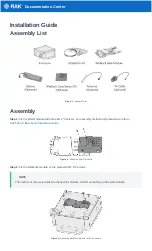
FOR I = 1 to 10
PRINT I
NEXT
are completely equivalent. However, if your program uses GOTO or GOSUB, these statements
require a line number; therefore the target (destination) line for a GOTO or GOSUB actually must
have a line number.
Indentation:
Indentation (spaces or tabs) can be used to make a program more readable. A tab is
equivalent to 4 spaces. Indentation is not a requirement. It’s just good programming practice.
FOR I = 1 to 10
PRINT I
NEXT
and
FOR I = 1 to 10
PRINT I
NEXT
are completely equivalent.
LED control:
The U4B board has an onboard red LED that can be a useful status indicator during
debugging and ground testing. In flight, it can be used as a strobe effect to warn approaching
aircraft. Use:
OUT 19, 1
to switch on the LED and
OUT 19, 0
to switch off the LED.
P.S. I’m joking about warning approaching aircraft in flight.
RF output power control:
U4B can transmit using the Si5351A chip’s Clk0 pin, whereupon the
Clk1 pin is grounded. This is called the low power mode and power output is approximately 9mW.
It can also drive the Clk0 pin and Clk1 pin in antiphase (180-degree phase shift), which results in
an output power of approximately 27mW. By default, the U4B will operate in low power mode. The
HP variable controls the transmitter power setting.
LET HP = 1
sets high power mode. Whereas:
LET HP = 0
sets the low power mode (default). If the high power mode is set, you will find that the U4B
requires higher light levels to be able to operate properly. As the sun comes up in the morning and
U4B operating manual Rev 1.00
23





































![Navig[8]r NAVBIKE-GPS User Manual preview](http://thumbs.mh-extra.com/thumbs/navig-8-r/navbike-gps/navbike-gps_user-manual_3574097-01.webp)










